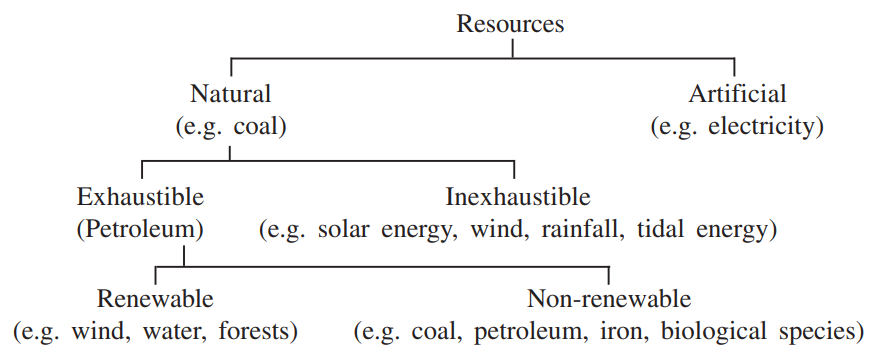Natural and Energy Resources: Solar, Wind, Hydro, Nuclear, Forests
Get Study Materials of General Studies for UPPSC ⇒ DOWNLOAD NOW
Natural and Energy Resources
Natural Resources: All things that nature has provided such as soil, air, water, minerals, coal, sunshine (sunlight), animals and plants, etc., are known as natural resources.
Artificial Resources: The resources, which have been developed by human beings during the growth of civilization, are called artificial resources. For example, Biogas, thermal electricity, plastics. These man-made resources are generally derived from some other natural resources. For example, plastics from the natural resource, petroleum.

We will discuss Natural and Energy resources in two parts; Natural Resources and Energy Resources.
Types of Natural Resources
The natural resources can be classified in the following ways:
Inexhaustible Resources
The resources which cannot be exhausted by human consumption are called inexhaustible resources. These include energy sources like solar radiation, wind power, water power (flowing streams) and tidal power, and substances like sand, clay, air, water in oceans, etc.
Exhaustible Resources
On the other hand, there are some resources, which are available in limited quantities and are going to be exhausted as a result of continuous use. These are called exhaustible resources. For example, the stock of coal, petroleum, and natural gases in the earth is limited and one day there will be no more coal available for our use.
Renewable Resources
Some of the exhaustible resources are naturally regenerated after consumption and are known as renewable resources. e.g. Forest trees and plants that make a forest may be destroyed but new ones grow in their place. But if the forest is totally cut down to get land for construction of buildings, it is lost forever. Some other examples are freshwater, fertile soil, forest (yielding wood and other products), vegetation, wildlife, etc.
Non-renewable Resources
The resources, which cannot be replaced after the use, are known as non-renewable resources. These include minerals (copper, iron etc.) fossil fuels (coal, oil etc.). Even wildlife species (rare plants and animals) belong to this category.
We have always been using different forms of energy obtained from various sources for our daily activities like cooking, heating, ploughing, transportation, lighting, etc.
For example, heat energy required for cooking purpose is obtained from firewood, kerosene oil, coal, electricity or cooking gas. LPG (liquefied petroleum gas) We use animal power (horse, bullock, etc.) for transportation and for running minor mechanical devices like the Persian wheel for irrigation or for running a “kolhu” for extracting oil from oilseeds. Different forms of these energies are obtained from various sources. We will discuss them in detail.
Types of Energy Resources
There are two main categories of energy sources:
1. Conventional Sources of Energy, which are easily available and have been in usage for a long time.
2. Non-Conventional Sources of Energy, that are other than the usual, or that are different from those in common practice.
The table below summarises the list of both the above categories of energy resources.
Types of Energy Resources
| Conventional Energy | Non-Conventional Energy | |
| Conventional Non-
renewable Energy (Mostly fossil fuels found under the Ground) | Conventional
Renewable Energy (Mostly non-fossil fuels seen above the Ground) | Solar Energy
Hydel Energy Wind Energy Nuclear Energy Hydrogen Energy Geothermal Energy Biogas Tidal Energy Biofuel |
| Examples: Coal, Oil, Natural gas etc. | Examples: Firewood, Cattle Dung, Farm, Vegetable Wastes,
Wood charcoal, etc. | |
Conventional Sources of Energy
Conventional sources of energy have been in used since ancient times. Most important among them are fossil fuels.
Fossil Fuels
Fossil fuels are the fossilised remains of plants and animals, which over millions of years have been transformed into coal, petroleum products and natural gas.
Coal is the most abundant fossil fuel. It is widely used for combustion in cooking and industrial activities. There are different types of coal products such as coal gas, coal tar, benzene, toluene, etc., which are used for various purposes.
Oil and Natural gases are formed from plants and animals which once lived in the tropical seas. Oil (or petroleum) is a source of countless products. Apart from petrol, diesel and other fuels, petroleum products include lubricants, waxes, solvents, dyes, etc. Petroleum reserves are supposed to last for another 100 years or so.
Natural gas is often found with petroleum. The gas mainly contains methane. Apart from serving as fuel in several industries, it is being increasingly used as a domestic fuel in many countries including India. The United States of America is the largest producer as well as consumer of natural gas.
Nowadays in big cities and towns, it is being supplied through pipelines which are called Piped Natural Gas (PNG). The natural gas is also used as a fuel to run vehicles. It is known as Compressed Natural Gas (CNG). It is accepted as an economical and less polluting fuel for transport.
The Liquefied Petroleum Gas (LPG) is the common cooking gas used in Indian homes. It is a mixture of propane and butane gases kept under pressure in liquid form, but they burn in gaseous form. This gas is made available in a specific container for domestic as well as industrial uses. It is a byproduct of petroleum refineries
Non-Conventional Sources of Energy
We have already learnt known about conventional sources of energy, whether renewable or non-renewable (coal, oil, etc.), which are fast depleting and will not last long. Therefore, greater utilisation of non-conventional sources of energy (solar, wind, hydro, geothermal, etc) will have to be used.
1. Solar Energy
Solar energy is the ultimate source of all energy on earth. Firewood, coal, oil or natural gas are the products of plants and other organisms, which had used solar energy for the synthesis of organic molecules during photosynthesis. Even today it will turn out to be the most important answer to problems of energy except nuclear energy.
The solar energy has the following advantages:
- It is abundant
- It is everlasting
- It is available almost
- It is free from political
2. Hydel /Hydro Energy
The generation of electricity by using the force of falling water is called hydroelectricity or hydel power. It is cheaper than thermal or nuclear power. For its generation dams are built to store water, which is made to fall to rotate turbines that generate electricity.
3. Wind Energy
Wind as an energy can be utilised in our daily life by converting it into mechanical energy. This mechanical energy is used to generate electricity, raise water from wells and rivers for irrigation and other purposes. Windmills have been in use since early times to provide power for grinding grains. It is also used for grain cutting and shelling. In India, a large number of windmills are being constructed on the sea beach and hilly areas.
Minimum wind speed required for operating the windmill is 7 km/hour. A windmill can draw water up to a maximum depth of 55 feet and the output is 4000-9000 litres (of water) per hour.
4. Tidal Energy
Tidal energy is one that is produced by making the use of water movement from high tide to low tide. Ocean waves and tides can be made to turn a turbine and generate electricity. Areas, where rivers flow into the sea experience waves and tides and electricity, can be generated there. It has much potential. As you know we have a large coastline and major river systems in our country, electricity can be generated on a large scale from waves and tides.
5. Nuclear Energy
Radioactive elements like uranium and thorium disintegrate spontaneously releasing large quantities of energy. This energy can be tapped to produce electricity. 25% of the world’s thorium reserve is found in our country, which can be utilised to generate electricity. Most advanced countries have nuclear power stations. We too have some in India, for example, Tarapur (Maharashtra), Kalpakkam (Tamil Nadu), Narora (Uttar Pradesh), Kota (Rajasthan). Approximately 3% of India’s electricity comes from nuclear power and about 25% is expected to come by 2050.
Installation costs of nuclear power stations are very high, but maintenance costs are relatively low. If not carefully maintained, these also have an inherent risk of causing radioactive pollution.
6. Hydrogen Energy
Hydrogen is the primary fuel for the hydrogen-based fuel cells and power plants. Power can be generated for industrial, residential and transport purposes by using hydrogen.
7. Geothermal Energy
This is the energy derived from the heat in the interior of the earth. In volcanic regions, springs and fountains of hot water called “geysers” are commonly found. These eruptions of hot steaming water can be used to turn turbines and produce electricity in geothermal power plants. In this method, cold water is allowed to seep through the fissures in the rocks until it reaches the hot rocks in the lower layers.
Water gets heated and gets converted into steam which forces out to the surface to be used in power generation. Besides the superheated steam of hot springs can also generate electricity. There are 46 hydrothermal areas in India where the water temperature normally exceeds 150-degree centigrade. Electricity can be generated from these hot springs.
8. Biogas (Biomass)
Another form of non-conventional energy is biogas. It is produced by the microbial activity on cattle dung in a specially designed tank called digester. A mixture of water and cattle dung is poured in this digester where anaerobic decomposition takes place and biogas is generated.
This gas contains 55 – 70 per cent methane, which is inflammable, and it is generally used as cooking gas and for the generation of electricity. The “waste” left in the tank after the generation of biogas is used as manures. Thus, biogas plant provides us with both the fuel and the manure. Biogas plants are becoming very popular in rural India.
9. Bio-fuel
The hydrocarbons present in such plants can be converted into petroleum hydrocarbons. This liquid hydrocarbon is the bio-fuel and the plants producing it are called petro-plants. The plant species, Jatropha curcus is the most suitable one, which yields bio-diesel. The Indian Oil Corporation is carrying out experiments for preparation of bio-diesel from various vegetable oils extracted from rice bran, palm, karanjia, sunflower etc.
Conclusion
We have discussed briefly Natural and Energy Resources including Solar, Wind, Soil, Hydro, Geothermal, Biomass, Nuclear and Forests. If you find any conceptual or human errors or missing any important points or topic, feel free to inform us either by commenting or email.
Useful links
Social links
Useful links
Contact Us
Address: B 14-15, Udhyog Marg, Block B, Sector 1, Noida, Uttar Pradesh 201301
Alpha-I Commercial Belt, Block E, Alpha I, Greater Noida, Uttar Pradesh 201310
